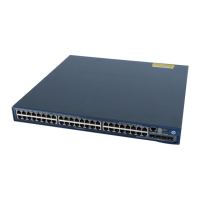126
2. Configure the secondary VLANs.
Assign non-trunk ports to each secondary VLAN and configure these ports as downstream ports.
To enable users in the isolate-user-VLAN to communicate with other networks at Layer 3,
configure VLAN interfaces for the secondary VLANs. Do not configure IP addresses for the
secondary VLAN interfaces.
3. Associate the isolate-user-VLAN with the specified secondary VLANs.
Configuring an isolate-user-VLAN
Follow these steps to configure an isolate-user-VLAN:
Create a VLAN and enter VLAN
view
Configure the VLAN as an isolate-
user-VLAN
Assign ports to the
isolate-user-VLAN
and ensure that at
least one port takes
the isolate-user-VLAN
as its PVID
For how to assign an access
port to a VLAN, see the
chapter ―VLAN configuration.‖
Required
Use either approach.
For how to assign a hybrid port
to a VLAN, see the chapter
―VLAN configuration.‖
Configure the isolate-user-VLAN type
of the port as upstream
port isolate-user-vlan
promiscuous
Optional
By default, no isolate-user-VLAN
type is specified for the port.
Create the isolate-user-VLAN
interface and enter the isolate-user-
VLAN interface view
interface vlan-interface vlan-
interface-id
This configuration is required
when users in the isolate-user-
VLAN need to communicate
with other networks at Layer 3.
This configuration is optional
when users in the isolate-user-
VLAN do not need to
communicate with other
networks at Layer 3.
The vlan-interface-id argument
must take the isolate-user-VLAN
ID.

